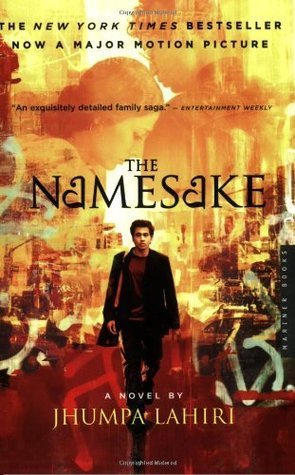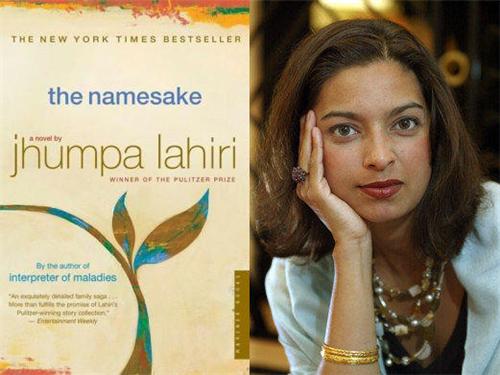The Namesake is the first novel written by Jhumpa Lahiri whose debut collection of short stories, Interpreter of Maladies, won the Pulitzer Prize in 2000. The novel deals with the identity issues of a boy in America, born to Bengali immigrant parents, who finds it difficult to agree with many things his parents say, starting with his name Gogol, which is borrowed from the Russian writer Nikolai Gogol, to whom his father is indebted. His American schoolmates make fun of him calling ‘Giggle’ or ‘Gargle’ and teachers stop startled at his name on the roster.
At 18, he legally forsakes Gogol for Nikhil, not for any affinity to the home culture but to establish his freedom and identity, pursues a course in architecture at Yale. His father’s untimely death calls him to the family duties, and he marries Maushmi a Bengali woman, with his mother’s will. However, he eventually turns a divorcee in a year.

The Namesake
Author: Jhumpa Lahiri, winner of the Pulitzer Prize.
Genre: Fiction
Publication: Harper Perennial
Ashima weds Ashoke, a doctoral candidate in electrical engineering at MIT in a typical Indian arranged marriage in Calcutta. The baby boy born to them in America they name Gogol. In the new country over and above the cultural shock, the child’s birth unsettles her, “As she strokes and suckles and studies her son, she can’t help but pity him. She has never known a person entering the world so alone, so deprived.”
Hardly any Indian immigrant mother in America absolves herself of such pity and guilt, the new world of unlimited material possibilities puts her in doubts of her newborn’s cultural existence.
Hardly any Indian immigrant mother in America absolves herself of such pity and guilt, the new world of unlimited material possibilities puts her in doubts of her newborn’s cultural existence.
Indians generally are rooted in the ethnic/caste/communal identities than in the national and resort to the tradition-set rules in the social and family matters at home. In America, this occurs in forms of cultural ethnocentrism and the romanticised self-pity of nostalgia about the distant home. They demand the same from the younger generation, which immediately sets conflicts in the relationship.
Lahiri in The Namesake, stages how this conflict develops on the Ganguly family foraging through the mental map of its members’ ego, unaffected attitudes, quirks of the adults and the perceptions, reactions and insecurities of the youngsters. Not through the telescopic view from the above or clichés, but Lahiri shows the real-life narratives of such everyday negotiations.

Image Source: Indian Ruminitions
The Everyday Of Gogol
Gogol is ten. On the day following the Halloween, he discovers his father’s surname Ganguly on their mailbox in gold letters got tainted, “The word GREEN scrawled in pencil following GANG.” During the last visit to Culcutta, he learned of his father’s pride about the legacy and popularity of his surname and he worries how this would upset him now. His father stands unaffected in front of the mailbox later purchases stuff from the shop to fix the mailbox.
Cashiers in supermarkets smirk at his parent’s accents, a direct insult at them but his father stays unaffected. In America, he has no self-pride!
Gogol is eleven in the sixth grade; his teachers and schoolmates are no more at odd with his name. He joins “a school field trip of some historical intent,” a part of which is to rub people’s names buried in an old grave on newsprints using crayons. The names he rubbed, though sounded odd like his own, fired an interest in him to bring them home to supplement his artwork collections on the kitchen wall. But his mother wouldn’t allow that.
How would she “…cook dinner for her family with the names of dead people on the walls? …Only in America (a phrase she has begun to resort to often these days), only in America, are children taken to cemeteries in the name of art. … In Calcutta, the burning ghats are the most forbidden of places…” Disheartened, he takes them to his room to bury in his cupboard.
A lot of works on Indian Americans use the glossy narratives of high-income groups, stable households, no divorce, Bollywood, music, yoga and so on. Lahiri in The Namesake is different agreeing with the facts and reality. Culture evolves, having protective and unifying functions but ethnocentric and egocentric views to preserve it as the set traditions makes a community regressive and the children at a loss.
Also read: Book Review: The Silence And The Storm By Kalpana Sharma
Lahiri’s Contrasting Portrayal of Indian Women In The Namesake
Ashima internalises femininity to sacrifice personal preferences to remain a dutiful wife in marriage. After thirty-three years in America when returns to India, she doesn’t fault her husband for his “…omissions of devotion, of affection…She knows now, (these) do not matter in the end.”
Maushami on the other hand, a first-generation American woman struggled her way fighting cultural odds and sexism to establish self-will and identity rushes headlong to marry Gogol and divorce him at the realization that, “…he was not who she saw ending up with, he had never been that person…being with him, falling in love with him, doing precisely what had been expected of her entire life, had felt forbidden, wildly transgressive, a breach of her own instinctive will.” Ashima’s pity for her son entering the world ‘so alone and deprived’ not only courses the novel forward but forebodes her son’s destiny.
The way Lahiri crafts the story, makes it a compelling read from the start to end. Her narrative is informal, conversational and relaxing. Its cumulative effect knocks you out. Her talent for observations and the prowess to detail the situations with witty expressions, smooth the path into each character’s world.
The End
As the story ends, we see Gogol sitting alone in the home he spent his early days with his family thinking, “…without people in this world to call him Gogol, no matter how long he lives, Gogol Ganguly will, once and for all, vanish from the lips of loved ones, and so cease to exist. Yet the thought of this eventual demise provides no sense of victory, no solace at all.”
Also read: Book Review: Ants Among Elephants By Sujatha Gidla
The way Lahiri crafts the story in The Namesake, makes it a compelling read from the start to end. Her narrative is informal, conversational and relaxing. Its cumulative effect knocks you out. Her talent for observations and the prowess to detail the situations with witty expressions, smooth the path into each character’s world. The novel was made into a major motion picture in the same name by Monsoon Wedding fame Mira Nair.
Born and grown up in Kerala, Prasannakumary likes writing a lot. She was a teacher by profession, now retired. She lives in Cape Town, South Africa. You can find her on Facebook.
Featured Image Source: India Online




